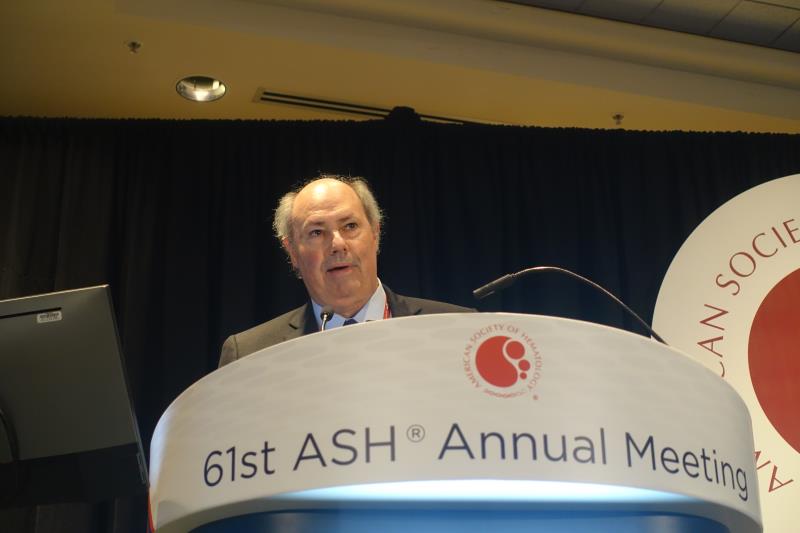 Professor Gary Raskob
Professor Gary RaskobIn acutely ill medical patients, asymptomatic proximal deep-vein thrombosis (ASxDVT), as assessed via compression ultrasonography, is associated with an elevated risk of all-cause mortality, according to a post hoc analysis of the MAGELLAN* trial presented at ASH 2019.
In the MAGELLAN trial, 8,101 patients aged ≥40 years who were hospitalized for an acute medical illness were randomized to receive rivaroxaban (10 mg QD for 35 days) or enoxaparin (40 mg QD for 10 days), followed by placebo through the observational period (up to day 90). The post hoc population comprised the 7,036 patients who had received ≥1 dose of the study drug and had an adequate ultrasound result at day 10 or 35. Patients were categorized into three groups: those without venous thromboembolism (VTE; n=6,776), those with symptomatic VTE (SxVTE; n=24), and those with ASxDVT (popliteal, femoral, or iliac vein thrombosis; n=236).
The risk of all-cause mortality at day 90 was higher among patients with ASxDVT than those with no VTE (11.4 percent vs 4.8 percent; hazard ratio [HR], 2.31, 95 percent confidence interval [CI], 1.52–3.51; p<0.0001). [ASH 2019, abstract 163]
All-cause mortality risk was even further elevated among patients with SxVTE compared with patients with no VTE (29.2 percent vs 4.8 percent; HR, 9.42, 95 percent CI, 4.18–21.20; p<0.0001).
There were 27, seven, and 322 deaths in the ASxDVT, SxVTE, and no VTE groups, respectively, predominantly due to causes such as cancer, infectious disease, and respiratory failure. Nine patients without VTE experienced bleeding vs none in the other two groups. Pulmonary embolism (PE) occurred in two patients without VTE and one patient with SxVTE. However, PE could not be excluded in four, one, and 74 patients in the ASxDVT, SxVTE, and no VTE groups, respectively.
“Relatively few patients … have a confirmed diagnosis of PE as a cause of death. Considerably more patients here have a case where they present with clinical features consistent with PE but with other things … in whom PE cannot be excluded as a cause of death,” said Professor Gary Raskob from the Hudson College of Public Health, University of Oklahoma Health Sciences Center, Oklahoma City, Oklahoma, US.
The researchers acknowledged that having only 88 percent of patients with ultrasound results presented a limitation, as was the fact that the results were derived from a post hoc analysis. Furthermore, the groups that the patients were categorized in were determined following randomization.
“ASxDVT is the precursor of most cases of clinically important PE, including most cases of fatal PE. Its presence has been associated with an increased [risk of] all-cause mortality in two previous studies of thromboprophylaxis in the medically ill,” said Raskob.
“[In this study] aSxDVT detected by routine ultrasound [was] associated with … clinically important higher and statistically significantly higher all-cause mortality in acutely ill medical patients. We believe that this is an indicator of clinically important disease and an appropriate endpoint for use in thromboprophylaxis trials in the medically ill,” he added.
“We also suggest that guidelines be updated to give consideration of this outcome in the number of outcomes that clinicians can consider in assessing the risk-benefit of thromboprophylaxis,” Raskob concluded.